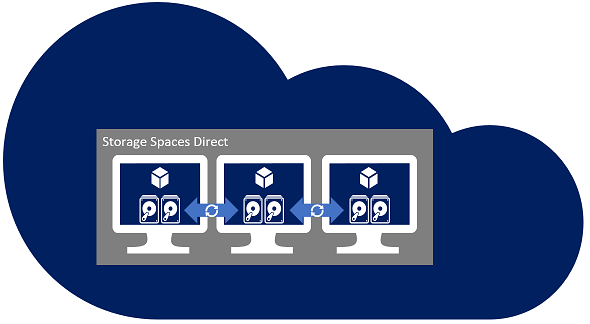Note
Access to this page requires authorization. You can try signing in or changing directories.
Access to this page requires authorization. You can try changing directories.
You can deploy Storage Spaces Direct on a cluster of physical servers or on virtual machine (VM) guest clusters as discussed in this article. This type of deployment delivers virtual shared storage across a set of VMs on top of a private or public cloud. This allows you to use application high availability solutions.
Requirements for guest clusters
The following considerations apply when deploying Storage Spaces Direct in a virtualized environment.
Minimum of two nodes and maximum of three nodes
Two-node deployments must configure a witness (Cloud Witness or File Share Witness)
Three-node deployments can tolerate one node down and the loss of one or more disks on another node. If two nodes shut down, then the virtual disks are offline until one of the nodes returns.
Configure the VMs to be deployed across fault domains
Azure – Configure the Availability Set
Hyper-V – Configure
AntiAffinityClassNameson the VMs to separate the VMs across nodesVMware – Configure the VM-VM Anti-Affinity rule by creating a DRS Rule of type "Separate Virtual Machines" to separate the VMs across ESX hosts. Disks presented for use with Storage Spaces Direct should use the Paravirtual SCSI (PVSCSI) adapter. For PVSCSI support with Windows Server, consult https://kb.vmware.com/s/article/1010398.
Use low latency / high performance storage such as Azure Premium SSD managed disks or faster
Deploy a flat storage design with no caching devices configured
Use a minimum of two virtual data disks presented to each VM (VHD / VHDX / VMDK)
This number is different than bare-metal deployments because the virtual disks can be implemented as files that aren't susceptible to physical failures.
Disable the automatic drive replacement capabilities in the Health Service by running the following PowerShell cmdlet:
Get-storagesubsystem clus* | set-storagehealthsetting -name "System.Storage.PhysicalDisk.AutoReplace.Enabled" -value "False"To give greater resiliency to possible VHD / VHDX / VMDK storage latency in guest clusters, increase the Storage Spaces I/O timeout value:
HKEY_LOCAL_MACHINE\\SYSTEM\\CurrentControlSet\\Services\\spaceport\\Parameters\\HwTimeoutdword: 00007530The decimal equivalent of Hexadecimal 7530 is 30000, which is 30 seconds. The default value is 1770 Hexadecimal, or 6000 Decimal, which is 6 seconds.
The following features aren't supported when using Storage Spaces Direct in a virtual machine guest cluster:
Host level virtual disk snapshot/restore
Instead use traditional guest level backup solutions to back up and restore the data on the Storage Spaces Direct volumes.
Host level virtual disk size change
The virtual disks exposed through the VM must retain the same size and characteristics. Adding more capacity to the storage pool can be accomplished by adding more virtual disks to each of the VMs, and then adding them to the pool. We recommend using virtual disks of the same size and characteristics as the current virtual disks.
Azure IaaS VM guest clusters
Azure templates decrease complexity, configure best practices, and speed your Storage Spaces Direct deployments in an Azure Iaas VM. This is the recommended solution for deploying in Azure.
Consider using Azure Shared Disks for guest virtual machines as an alternative, see Azure Shared Disks.

Next steps
To deploy Storage Spaces Direct in a virtual machine guest cluster, see the following articles: